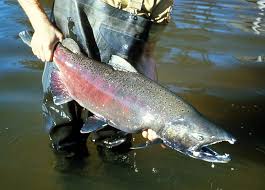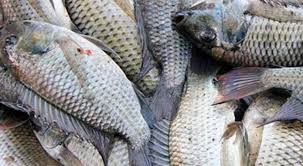1. Order Acipenseriformes (Sturgeons and Paddlefishes)
This order contains two families, the sturgeons (Acipenseridae) and the paddlefishes (Polyodontidae – see below) both of which occur in North America. These fishes are found in freshwaters; however, some are anadromous. (Anadromous fish are born in fresh water, migrate to the ocean to grow into adults, and then return to fresh water to spawn.)
They are among the largest freshwater fishes, and are remnants of an ancient and primitive group. Members of this order have largely cartilaginous skeletons, upper jaws that are not united with the skull, and heterocercal caudal fins. (Heterocercal caudal fin which means that the upper lobe is larger than the lower lobe and produces a downward thrust; when used with the pectoral fins it provides a forward motion.
2. Order Lepisosteiformes (Gars)
This order consists of a single family, 2 genera and 7 species worldwide with 5 of them in North America. Gars are mostly fresh water and are long, slender, predatory fishes covered with interlocking ganoid scales that protect them from most predators.
Extremely hardy, gars typically inhabit quiet, weedy backwater areas. They have elongated jaws with needle-like teeth and are equipped with a vascularised swim bladder to permit aerial respiration. The single dorsal fin is located posteriorly on the body above the anal fin.
3. Order Cypriniformes (Minnows Carps and Suckers)
This order of fish has 2,662 species, with the greatest diversity of species found in Southeastern Asia. All the fish in this order lack teeth in their mouths. Many species are used for food, aquarium fish, or research. Some common examples are the goldfish, minnows, and loaches.
4. Order Siluriformes (North American catfishes)
This large order contains 34 families, but in the US there are only 2 native families with most belonging to the Ictaluridae.
North American catfishes are closely related to the Cypriniformes because both groups have an organ connecting the swim bladder with the inner ear, providing an excellent hearing. The Ictaluridae have four pairs of barbells, an adipose fin, and each dorsal and pectoral fin has a single spine.
Read Also: Understanding Fish Identification Process
5. Order Esociformes (Pikes and Pickerels)
There are two families in this small order, both of which occur in North America. These freshwater fishes have elongated to relatively elongated bodies, with the dorsal and anal fins located far back on the body. They lack adipose fins, and breeding males do not have tubercles.
6. Order Salmoniformes (Trout and Salmon)

This order contains 2 families, both of which are found in North America. Smelts (Osmeridae) and Trouts and Salmons (Salmonidae). They include freshwater, marine, anadromous, and deep-sea species. All have soft-rayed fins, adipose fins, and abdominal pelvic fins.
7. Order Scorpaeniformes (Sculpins)
Head and body tend to be spiny or have bony plates; pectoral fin usually rounded, membranes between lower rays often incised; caudal fin usually rounded (occasionally truncate, rarely forked).
8. Order Perciformes (Temperate Basses, Sunfish, Perches, and Drums)
Perciformes is not only the largest order of fish, but also the largest order of all vertebrates. There are 9,293 species, which is more than one third of all the fish species in the world. Most members of this order are marine fish, but about 2,000 species are fresh water. Many species of marine fish do spend part of their life cycle in freshwater.
Read Also: Morphology and Basic Structures of Fisheries
Read Also: Strategies for Reducing Water Pollution

